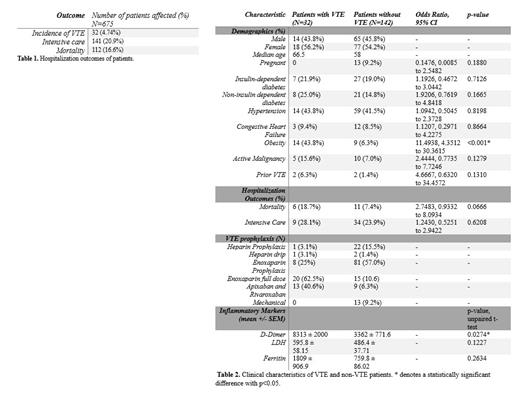Purpose/Objective:
COVID-19 is a significant cause of morbidity and mortality in the inner-city population in New York City (NYC), with COVID-19 coagulopathy and venous thromboembolism (VTE) as major contributing factors. A recent meta-analysis of 17 studies demonstrated a pooled 25% increased risk of VTE incidence in hospitalized COVID-19 patients (Zhang et. al, 2020). To assess morbidity burden, the primary objective of this current study is to investigate COVID-19 coagulopathy incidence in hospitalized patients in an Afro-Caribbean NYC population. The secondary objective was to assess the clinical characteristics and risk factors of COVID-19 coagulopathy, classify disease severity and outcomes.
Methods:
A retrospective study was performed at the NYC Health and Hospitals/Kings County on patients hospitalized with COVID-19. Data was collected from March 1 st, 2020 to December 31 st, 2021 for hospitalized and intensive care patients. Information was collected on the incidence of VTE, type of VTE (deep vein thrombosis or pulmonary embolism), demographics, VTE prevention strategies, VTE management, inflammatory markers, and outcomes. GraphPad PRISM was used for statistical analysis, through unpaired t-tests and odds ratios, with p<0.05 indicating statistical significance.
Results:
The primary objective investigated 675 patients to assess COVID-19 incidence, with imaging-confirmed VTE incidence in 32 (4.74%), and mortality in 112 (16.6%) patients (Table 1). To assess factors that influence VTE, we assessed demographic, outcome and infection severity between 32 VTE patients, and 142 non-VTE patients (Table 2). Multivariable analysis of comorbidities demonstrated that obesity was an independent risk factor for VTE (OR=11.4938, 95% CI 4.3512 to 30.3615, p<0.001). Interestingly, prior VTE did not increase the risk of VTE between cohorts. Further, there is a trend towards increased mortality risk in VTE patients compared to non-VTE patients, although not statistically significant (OR= 2.7483, 95% CI 0.9332 to 8.0934, p=0.0666). We were unable to deduce differences between VTE prevention strategies between the cohorts due to insufficient power. Upon analyzing inflammatory markers, D-Dimers were determined to be significantly elevated in VTE patients compared to non-VTE patients (p=0.0274), whereas there was no significant difference between LDH or ferritin between the cohorts.
Conclusions/Implications:
This study characterized the incidence and demographics of COVID-19 coagulopathy in a safety net NYC hospital, wherein there is decreased VTE incidence compared to prior published literature (Zhang et. al, 2020). Our study also supports current literature which identifies obesity as a risk factor for VTE in COVID-19 patients (Wang et al, 2021). We hypothesize that BMI reduction may be protective against COVID-19 induced VTE risk, and targeted BMI reduction programs may mitigate COVID-19 severity. Future studies should continue to investigate COVID-19 risk reduction strategies in patients with comorbidities and can consider anticoagulation use based on risk factors.
Disclosures
No relevant conflicts of interest to declare.


